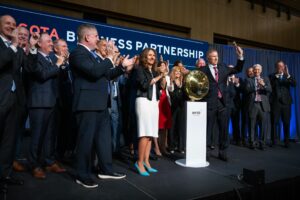
This Op Ed was published in the Star Tribune on July 28, 2025. Below is a copy of the piece.
Opinion | Minnesota’s NYSE moment was more than pageantry — it was a wake-up call
The state’s business culture is unique, and keeping it requires smart action.
By Kurt Zellers
On July 10, something extraordinary happened in Fridley. We rang the opening bell of the New York Stock Exchange — not from Wall Street, but at Medtronic’s headquarters, with CEOs from across our state.
As someone who has spent decades watching economic ecosystems rise and fall, I can tell you this wasn’t just corporate theater. It was proof that Minnesota has built something genuinely rare: a headquarters economy that works.
When NYSE Group President Lynn Martin made the trip to Minnesota, she came because the numbers demanded attention. Minnesota hosts 30 NYSE-listed companies and more Fortune 500 headquarters per capita than any other metro area in America. But what caught Martin’s eye wasn’t just our numbers — it was our culture. She specifically noted the “collaborative nature” of Minnesota’s business leaders.
That collaboration isn’t just Midwestern niceness. It’s competitive advantage. When Best Buy’s CEO Corie Barry and nVent’s Chair and CEO Beth Wozniak joined Martin for a NYSE panel discussion that morning, they weren’t competing for airtime — they were building on each other’s points about Minnesota’s ecosystem. When challenges hit our state, from the Interstate 35W bridge collapse to COVID-19, our business community doesn’t retreat to boardrooms and play blame games. We roll up sleeves and solve problems together.
This collaborative culture has created something powerful: an ecosystem where talent can thrive without choosing between professional ambition and community roots. As General Mills Chairman and CEO Jeff Harmening noted during the event, Minnesota’s educational commitment has created “a pipeline of talent — engineers, marketers, scientists, data analysts, designers and health professionals — who didn’t have to leave their hometown to pursue their careers.”
Our member companies employ one-sixth of all Minnesota workers. That’s not market dominance — that’s market responsibility. These aren’t financial engineering plays or private equity roll-ups. From Medtronic’s lifesaving devices to Cargill’s feeding the world, these companies make things, grow things, heal people and solve problems.
I’ve seen what happens when ecosystems get taken for granted. As Medtronic’s CEO Geoff Martha warned our gathering, “It doesn’t take long to see a state fall apart.”
Connecticut had a robust headquarters economy until companies migrated south. Illinois watched corporate departures accelerate as policymakers treated businesses like ATMs rather than economic engines. California, with all its advantages, is seeing headquarters relocate to more business-friendly states. Minnesota needs a strategy to stay competitive.
The competitive threats are real and accelerating. While we celebrated our NYSE moment, Georgia was probably updating its corporate recruitment materials with our companies’ names on them. The math is simple: If it’s easier and cheaper to build a company in Texas or Tennessee, that’s where the next generation of Fortune 500 companies will be born.
Teddy Roosevelt had it right when he said, “The welfare of each of us is dependent fundamentally upon the welfare of all of us.” He understood that businesses and communities succeed together — which is exactly what Minnesota’s headquarters economy represents.
This reality creates urgency around a fundamental question: Are we creating policies that support both business success and broader prosperity? Minnesota has the nation’s second-highest business tax rate at 9.8%, making our cultural advantages even more critical to maintain. But culture alone won’t be enough if policymakers treat our headquarters economy as inevitable rather than fragile.
Standing in that room earlier this month, watching the bell ring as markets opened thousands of miles away, I realized this wasn’t Minnesota taking a victory lap. It was Minnesota taking inventory.
We’ve built something distinct: a headquarters economy combining global competitiveness with community commitment. But as any farmer knows, the harvest celebrates work already done — it doesn’t guarantee next year’s crop.
The collaborative culture that made an impression on the NYSE president needs extending beyond corporate boardrooms to include policymakers, educators and community leaders. The talent pipeline keeping companies here needs expanding for tomorrow’s jobs. The business environment that attracted companies initially needs strengthening before competitors do it better.
We rang the NYSE bell from Minnesota not because we’ve arrived, but because we’re just getting started. The question isn’t whether we’re America’s headquarters economy today — it’s whether we’ll still hold that distinction in 2035.
The bell has been rung. The work begins now.
Kurt Zellers is CEO of the Minnesota Business Partnership, representing more than 100 CEOs from Minnesota’s largest employers. He is a former speaker of the Minnesota House.